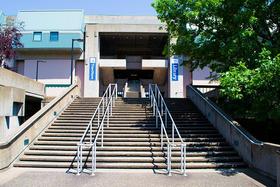- Lancaster General College of Nursing & Health Sciences is a private, co-educational, Middle States-accredited, four-year college offering a variety of associate and baccalaureate degree programs as well as certificate programs in healthcare. The College is located in Lancaster, Pa., a city of 56,000 situated in the heart of picturesque Lancaster County. A select group of more than 900 students study with faculty who are experts in their specialty areas. Lancaster General College is the educational arm of the Lancaster General Health system. Lancaster General College of Nursing and Health Sciences offers a variety of academic programs for the aspiring healthcare professional. For more information about our programs, please visit the individual program pages via the links to the left, read brief descriptions of the programs immediately below, or see our Academic Resources page (link on the left side of this page) for information including the Academic Calendar, Academic Policies, Accreditation, the College Catalog, and much more.
School Highlights
Pennsylvania College of Health Sciences serves 2,178 students (28% of students are full-time).
The college's student-teacher ratio of 14:1 is lower than the state community college average of 15:1.
Minority enrollment is 37% of the student body (majority Hispanic and Black), which is less than the state average of 48%.
Quick Facts (2025-26)
- Enrollment: 2,178 students
- Private-state tuition: $23,045
- Acceptance Rate: 49%
- Student-teacher ratio: 14:1
- Minority enrollment: 37%
- Source: Verified school update
Top Rankings
Pennsylvania College of Health Sciences ranks among the top 20% of public schools in Pennsylvania for:
School Overview
The teacher population of 161 teachers has stayed relatively flat over five years.
Pennsylvania College of Health Sciences
(PA) Community College Avg.
Carnegie Classification
Special Focus Four-Year: Other Health Professions Schools
Not applicable, not in Carnegie universe (not accredited or nondegree-granting)
Institution Level
Four or more years
At least 2 but less than 4 years
Institution Control
Private not-for-profit
Private not-for-profit
Total Faculty
161 staff
59 staff
School Calendar
Student Body
The student population of Pennsylvania College of Health Sciences has grown by 20% over five years.
The student-teacher ratio of 14:1 has increased from 12:1 over five years.
The Pennsylvania College of Health Sciences diversity score of 0.56 is less than the state average of 0.68. The school's diversity has grown by 28% over five years.
Total Enrollment
2,178 students
461 students
Student-Teacher Ratio
14:1
15:1
# Full-Time Students
616 students
325 students
# Part-Time Students
1,562 students
136 students
# Enrollment Undergraduate
199 students
298 students
# Full-Time Undergraduate Students
614 students
326 students
# Full-Time Graduate Students
2 students
10 students
# Part-Time Undergraduate Students
1,383 students
151 students
# Part-Time Graduate Students
179 students
12 students
Total Dormitory Capacity
n/a
330 students
% American Indian/Alaskan
n/a
n/a
% Asian
5%
5%
% Hispanic
16%
11%
% Black
12%
15%
% White
63%
52%
% Hawaiian
n/a
3%
% Two or more races
3%
3%
% Non Resident races
n/a
1%
% Unknown races
1%
10%
Diversity Score
0.56
0.68
College Completion Rate (Students who graduate in less than 4 years)
75%
62%
College Completion Rate (Students who graduate in 4 years or more than 4 years)
58%
36%
Average Graduate Earnings (10 Years)
$52,900
$34,900
Tuition and Acceptance Rate
The private state tuition of $23,045 is more than the state average of $17,231. The private state tuition has declined by 22% over four years.
Private State Tuition Fees
$23,045
$17,231
Tuition Notes
$683 per Credit (2024-2025 Academic Year)
% Students Receiving Some Financial Aid
75%
88%
Median Debt for Graduates
$17,500
$13,000
Median Debt for Dropouts
$9,500
$6,260
Acceptance Rate
49%
78%
SAT Total Avg.
1,000
930
SAT Reading
495
460
SAT Math
505
470
SAT Writing
n/a
435
ACT Composite
n/a
20
ACT English
22
18
ACT Math
22
19
ACT Writing
n/a
7
Source: 2024 (or latest year available) Integrated Postsecondary Education Data System (IPEDS) , School Administrators
Frequently Asked Questions
How much does Pennsylvania College of Health Sciences cost?
Pennsylvania College of Health Sciences's private state tuition is approximately $23,045.
What is the acceptance rate of Pennsylvania College of Health Sciences?
The acceptance rate of Pennsylvania College of Health Sciences is 49%, which is lower than the state average of 78%. Pennsylvania College of Health Sciences's acceptance rate is ranked among the top community colleges in Pennsylvania with low acceptance rates.
What is Pennsylvania College of Health Sciences's ranking?
Pennsylvania College of Health Sciences ranks among the top 20% of community college in Pennsylvania for: Lowest acceptance rates and Largest student body.
Recent Articles

How to Transfer from Community College to a Four-Year University in 2025
A step-by-step guide for community college students transferring to a four-year university in 2025 — updated strategies, data and expert insights.

Scholarships for Community College Students 2025
Explore updated scholarship programs, tuition data, and expert strategies for community college students in 2025.

The Rise of Technical and Vocational Training in 2025
Explore the 2025 surge in technical and vocational training—enrollment, policy, costs, and why this path is gaining ground for students and parents.











